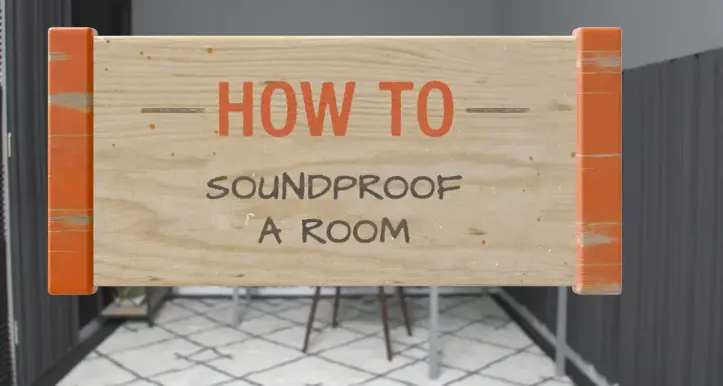Making your home or office quiet can seem hard. But, with the right steps, you can make a peaceful space. This guide will show you how to soundproof a room. You’ll learn about key materials, step-by-step guides, and expert tips for walls, ceilings, floors, doors, and windows.
Whether it’s to block out neighbor noise or just make your space calmer, we’ve got you covered. You’ll get the tools and knowledge to turn your area into a quiet haven.
Key Takeaways
- Understand the basics of sound transmission and noise control to identify the best soundproofing solutions for your space.
- Discover the essential materials and step-by-step process for effectively soundproofing a room.
- Learn professional techniques for soundproofing walls, ceilings, floors, doors, and windows to maximize noise reduction.
- Explore budget-friendly DIY soundproofing solutions to improve the acoustics of your room.
- Avoid common mistakes and implement advanced sound dampening methods for maximum noise reduction.
Understanding Sound Transmission and Noise Control Basics
Learning to soundproof a room starts with knowing how sound works. We’ll explore the types of sound, how they move through materials, and the science of sound absorption and reflection.
Different Types of Sound: Airborne vs. Impact Noise
Our homes face two main sound challenges: airborne and impact noise. Airborne noise travels through the air, like voices or music. Impact noise comes from physical vibrations, like footsteps. Knowing the difference helps us soundproof better.
How Sound Travels Through Building Materials
Sound waves can go through many building materials, like walls and floors. The material’s density and type affect how well it blocks sound. Denser materials, like concrete and blocks, sound better than lighter ones like wood.
The Science Behind Sound Absorption and Reflection
“The key to effective noise control lies in understanding the principles of sound absorption and reflection.”
When sound hits a surface, it can be absorbed or reflected. Sound absorption turns sound energy into heat, lowering the noise. Sound reflection sends sound waves back, causing echoes. Using sound-absorbing materials can help control unwanted noise.
Essential Materials for Effective Room Soundproofing
Choosing the right materials is key to soundproofing a room. You’ll find options like acoustic insulation and soundproofing materials. These can greatly improve your room’s acoustics.
Acoustic foam panels are a popular choice. They absorb sound waves, cutting down on echoes and reverberations. You can pick from various shapes, sizes, and densities to fit your needs.
Mass-loaded vinyl (MLV) is another great option. It’s a dense, flexible material that blocks airborne sound. You can use it on walls, floors, and ceilings for a comprehensive soundproofing solution.
Soundproof curtains are also effective. They absorb sound, creating a barrier against external noise. This helps to isolate the room.
Weatherstripping is crucial for soundproofing too. It seals gaps and cracks around doors and windows. This prevents sound from entering or leaving the room, boosting soundproofing.
When picking soundproofing materials, consider the noise sources, room size, layout, and budget. By weighing the pros and cons of each, you can find the perfect solution. This will enhance your room’s acoustic comfort.
How Do You Soundproof a Room: Step-by-Step Process
Soundproofing a room needs a careful plan. It starts with checking the room, finding sound leaks, and making a detailed plan. This ensures the room stays quiet.
Initial Room Assessment
First, look at the room you want to soundproof. Check its size, what it’s made of, and how it sounds. Knowing this helps pick the right ways and materials to block out noise.
Identifying Sound Leakage Points
Find where sound can get in or out. Look at walls, floors, ceilings, doors, and windows for any holes or gaps. Fixing these spots is key to stopping noise.
Creating a Soundproofing Strategy
- Make a detailed plan to tackle both airborne and impact noise.
- Use sound-absorbing materials, add mass, and dampen vibrations for a strong defense.
- Focus on sealing sound leaks to keep noise from getting in or out.
By following these steps, you can make a room quieter. You’ll get the best results for your specific needs.
Soundproofing Walls: Professional Techniques and Methods
Walls are key to soundproofing a room. Experts use many techniques to improve acoustic insulation, sound blocking, and room acoustics. These methods can make your space quieter and more peaceful.
Adding Mass to Walls
One main way to soundproof walls is to make them heavier. This is done with materials like mass-loaded vinyl, double drywall, or concrete blocks. Adding weight to the wall helps block airborne noise.
Decoupling Techniques
Decoupling means separating the inner and outer walls. A gap is created and filled with sound-absorbing insulation. This stops impact noise from passing through. Professionals use resilient channels and staggered studs for this.
Sound-Absorbing Materials
- Acoustic panels: Sound-absorbing panels on walls can trap sound, lowering noise levels.
- Acoustic insulation: Fiberglass or mineral wool insulation in walls absorbs sound.
- Acoustic caulk: Acoustic caulk seals gaps, stopping sound leaks.
Using these professional methods, you can make your walls soundproof. This turns any space into a quiet retreat.
Ceiling and Floor Soundproofing Solutions
Creating a quiet home is more than just soundproofing walls. It’s also about sound-dampening ceilings and floors. This helps reduce noise and makes your home peaceful. Homeowners can use various methods, like drop ceilings and floating floors, to improve sound dampening.
Drop Ceiling Installation Methods
Drop ceilings are a smart way to dampen sound. They use a grid system and acoustic panels to absorb sound. This setup helps keep noise from moving between floors, making your home quieter.
Floating Floor Construction
Floating floors are great for sound dampening between floors. They’re not fixed to the subfloor, which stops noise and vibrations from passing through. Choosing the right underlayment options is essential for the best noise reduction.
Underlayment Options and Installation
- Foam underlayment: Provides a cushioned layer that absorbs impact noise and vibrations.
- Cork underlayment: Offers superior sound-absorbing properties and improved thermal insulation.
- Rubber underlayment: Effectively dampens both impact and airborne noise, creating a more quiet home.
Installing underlayment correctly is vital. Paying attention to seams and edges ensures the best sound dampening from a floating floor system.
Door and Window Acoustic Treatment Strategies
Soundproofing a room often starts with improving doors and windows. These areas can let sound escape, making it hard to keep a room quiet.
To fix this, there are a few things you can do:
- Solid Core Doors: Switching to solid-core doors can make a big difference. They block sound better than hollow-core doors because they’re denser.
- Soundproof Weatherstripping: Using top-notch weatherstripping around doors and windows seals gaps. This stops sound from getting in.
- Window Plugs: You can also use window plugs or inserts to block sound. They fit over windows to add extra sound protection.
Sealing air gaps and ensuring doors and windows are well-sealed is key. This makes any soundproofing efforts more effective. By using these methods, you can greatly improve your room’s noise control and sound blocking.
“Proper sealing and acoustic treatment of doors and windows is essential for achieving optimal soundproofing in a room.”
Advanced Sound Dampening Methods for Maximum Noise Reduction
There are advanced techniques for better sound isolation. Methods like mass-loaded vinyl, double wall construction, and resilient channel installation are great for rooms needing lots of noise reduction. This includes home theaters or professional music studios.
Mass Loaded Vinyl Application
Mass-loaded vinyl (MLV) is a dense material that blocks noise. It’s applied to walls, ceilings, or floors to improve sound dampening and noise reduction. This heavy, limp vinyl works well with other materials for better acoustic insulation.
Double Wall Construction
A double wall system is another effective method. It involves building two walls with a gap in between. This creates an air cavity that stops sound from passing through. The air space and damping materials inside offer top-notch acoustic insulation and noise reduction.
Resilient Channel Installation
Resilient channels are metal or plastic profiles installed between the wall framing and drywall. They act as a decoupling mechanism, stopping sound from passing through. This leads to better noise reduction performance.
Using these advanced sound dampening techniques can greatly improve any space’s acoustic performance. You’ll get maximum noise reduction for your needs.
Budget-Friendly DIY Soundproofing Solutions
Homeowners looking to cut down on noise can find affordable DIY solutions. Materials like mass loaded vinyl, acoustic panels, and weatherstripping are effective and won’t empty your wallet. They help make your home quieter.
Applying acoustic caulk around windows and doors is a simple yet effective trick. This sealant blocks airborne noise, enhancing soundproofing. Mass loaded vinyl, a dense material, can also be used to absorb noise in specific areas.
If you’re on a tight budget, think about using items you already have. Blankets, rugs, and curtains can improve room acoustics. Hanging heavy fabrics on walls or using them as door and window treatments can surprisingly reduce noise. With a bit of creativity, you can turn your home into a quiet home using soundproofing materials you already have.



